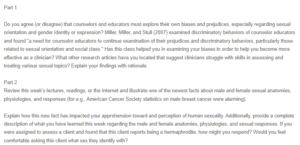PSY 4040 Human Sexuality W2D
Part 1
I agree that counselors and educators must actively explore their own biases and prejudices, particularly in areas related to sexual orientation and gender identity or expression. Miller et al. (2007) study highlights the importance of ongoing self-examination by counselor educators to address discriminatory behaviors, especially concerning sexual orientation and social class. The exploration of personal biases is crucial for fostering a more inclusive and effective therapeutic environment.
This class has been instrumental in prompting self-reflection and examining biases. The articles provided further emphasize the challenges faced by clinicians in assessing and treating various sexual topics. For instance, Grove’s (2009) study explores the competence of trainee counselors in working with lesbian and bisexual clients, shedding light on the need for targeted training. Satcher & Leggett (2007) address homonegativity among professional school counselors, indicating the existence of biases within the counseling profession itself. These findings underscore the ongoing need for education and training to enhance clinicians’ skills in addressing diverse sexual orientations and identities. By acknowledging and addressing biases, counselors can provide more inclusive and effective support to clients.
Part 2
One of the newest facts about male and female sexual anatomies, physiologies, and responses is the concept of neuroplasticity in sexual function. Research suggests that the brain can reorganize itself in response to experience, and this extends to sexual experiences (Miller et al., 2007). This finding challenges traditional views on sexual response and highlights the complexity of human sexuality.
This new understanding has impacted my apprehension toward human sexuality by emphasizing the dynamic nature of sexual responses and the importance of considering psychological factors in sexual health. It underscores the need for a holistic approach to sexual well-being that incorporates both physical and psychological aspects (Miller et al., 2007). In this week’s learning, the exploration of male and female anatomies, physiologies, and sexual responses has deepened my understanding of the interconnectedness of biological and psychological factors in human sexuality. I have gained insights into the variability of sexual experiences and the importance of considering individual differences.
If assigned to assess a client who reports being a hermaphrodite, I would approach the situation with sensitivity and respect for the client’s experiences. I would create a safe and non-judgmental space for the client to discuss their identity and preferences. I would feel comfortable asking the client about their gender identity, ensuring that my questions are framed in a respectful and affirming manner, with a focus on understanding and supporting the client’s unique needs.
References
Grove, J. (2009). How competent are trainee and newly qualified counsellors to work with lesbian, and bisexual clients and what do they perceive as their most effective learning experiences. Counselling & Psychotherapy Research, 9(2), 78-85. DOI: https://doi.org/10.1080/14733140802490622
Miller, K. L., Miller, S. M., & Stull, J. C. (2007). Predictors of counselor educators’ cultural discriminatory behaviors. Journal of Counseling & Development, 85(3), 325–336.
Satcher, J., & Leggett, M. (2007). Homonegativity among professional school counselors: An exploratory study. Professional School Counseling, 11(1), 10–16.
ORDER A PLAGIARISM-FREE PAPER HERE
We’ll write everything from scratch
Question
Part 1
Do you agree (or disagree) that counselors and educators must explore their own biases and prejudices, especially regarding sexual orientation and gender identity or expression? Miller, Miller, and Stull (2007) examined discriminatory behaviors of counselor educators and found “a need for counselor educators to continue examination of their prejudices and discriminatory behaviors, particularly those related to sexual orientation and social class.” Has this class helped you in examining your biases in order to help you become more effective as a clinician? What other research articles have you located that suggest clinicians struggle with skills in assessing and treating various sexual topics? Explain your findings with rationale.

PSY 4040 Human Sexuality W2D
Part 2
Review this week’s lectures, readings, or the Internet and illustrate one of the newest facts about male and female sexual anatomies, physiologies, and responses (for e.g., American Cancer Society statistics on male breast cancer were alarming).
Explain how this new fact has impacted your apprehension toward and perception of human sexuality. Additionally, provide a complete description of what you have learned this week regarding the male and female anatomies, physiologies, and sexual responses. If you were assigned to assess a client and found that this client reports being a hermaphrodite, how might you respond? Would you feel comfortable asking this client what sex they identify with?

